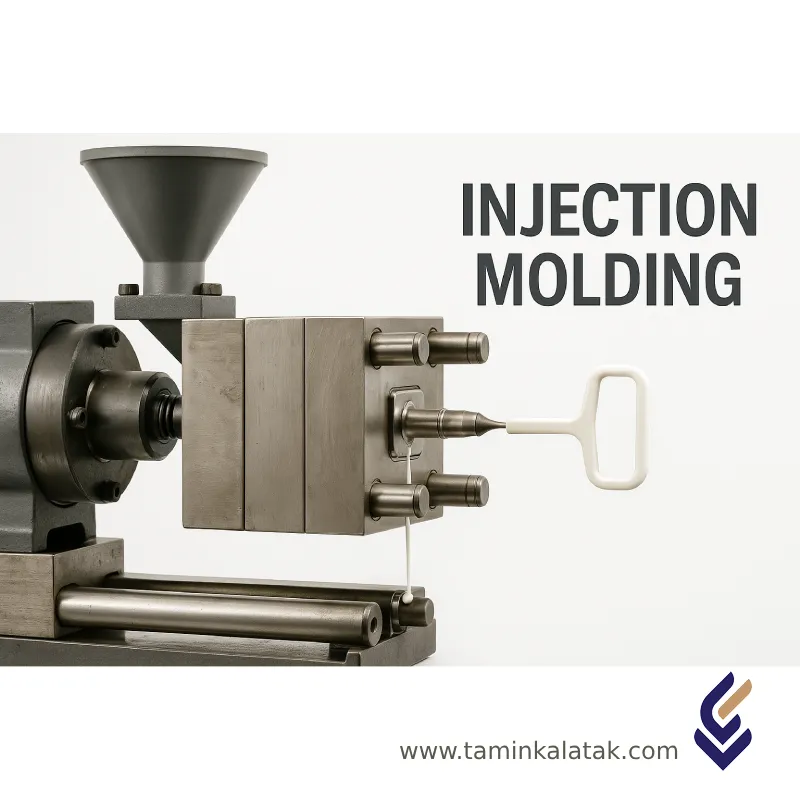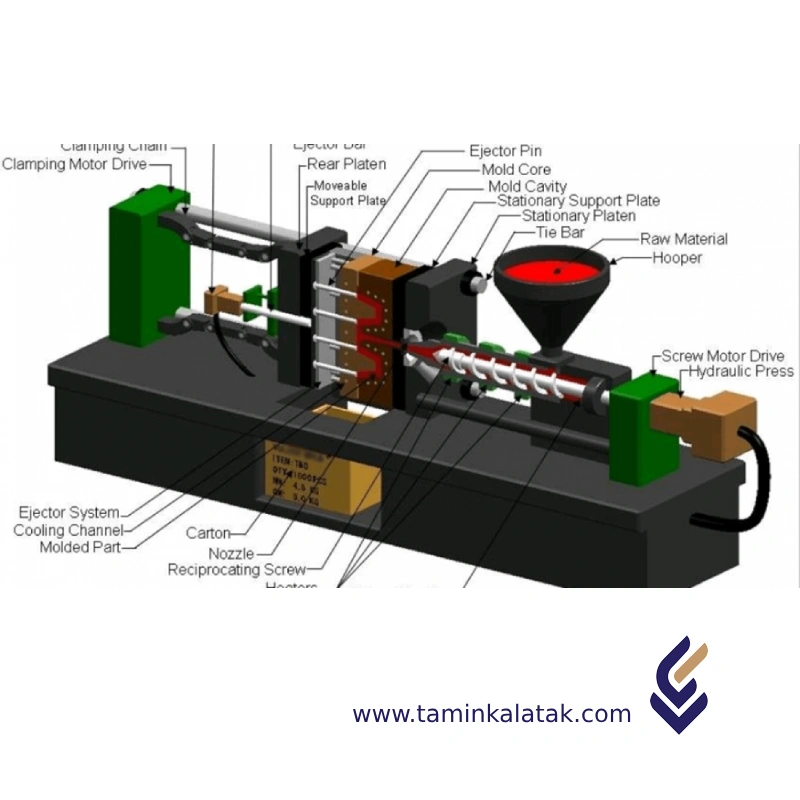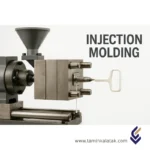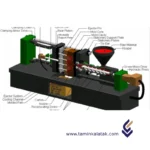Polymers are made up of very large molecules made up of many repeating units called monomers, which ultimately form this long polymer chain
HDPE stands for High-Density Polyethylene, which is one of the most widely used materials in the world and is used in various industries due to its unique properties.
Injection Molding
In injection molding, polymer granules are compressed by a ram or screw, heated until molten and squirted into a cold, split mold under pressure (Figure 26.3(b)). The molded polymer is cooled below TG, the mold opens and the product is ejected. Excess polymer is injected to compensate for contraction in the mold. The molecules are oriented parallel to the flow direction during injection, giving useful strengthening, but properties that are anisotropic. The process gives high-precision moldings, because the polymer cools with the pressure still on but is slow (the cycle time is between 1 and 5 min), and the molds are expensive. Typically, molding temperatures for thermoplastics are between 150 and 350 °C (1.3 and 1.6 TG) and the pressures needed to give good detail are high—typically 30–120 MN m−2.
Types of injection molding
Gas-Assisted Injection Molding
This process involves injecting gas (commonly nitrogen) into the molten polymer during molding. The gas pushes the molten plastic against the mold walls, creating hollow sections or reducing the amount of material used.
Thin-Wall Injection Molding
This method Focuses on producing parts with very thin walls, typically less than 1 mm. This requires specialized molds and machines capable of handling high pressures and fast cycle times.
Liquid Silicone Rubber (LSR) Injection Molding
This method is Used exclusively for liquid silicone rubber (LSR), a thermosetting material that cures when heated. LSR is injected into a heated mold, where it solidifies into a flexible and durable part.
Structural Foam Molding
A process where a foaming agent or gas is added to the polymer to create parts with a cellular core and solid outer skin. This reduces density and weight while maintaining strength.
Metal Injection Molding (MIM)
A process that combines metal powders with a polymer binder to create a feedstock. The feedstock is injected into a mold, then the binder is removed, and the part is sintered to achieve a dense metal component.
Advantages of injection molding
- Injection molding is incredibly cost-effective, especially in high-volume applications where thousands to tens of thousands of parts are printed in a workday.
- Injection molding offers many different materials, both general use, and specialty.
- Injection molding provides immense design freedom to product developers and is only held back by mold design, material specifications, and cost.
- Injection-molded parts can be as small as a grain of rice (or smaller) or can be as large as a car dashboard, depending upon the specific type of injection molding being used.
- Injection molding can produce highly complex parts that would otherwise be too time-consuming or difficult to produce with traditional subtractive manufacturing methods.
- Injection molding is a low/no waste manufacturing method, and waste can typically be 100% recycled and reground into stock material for a new injection mold.
Disadvantages of injection molding
- High initial tooling and equipment costs.
- Long lead times for mold design and production.
- Material limitations and risk of defects.
- Environmental and sustainability concerns.
- Design constraints requiring engineering expertise.
- Best suited for high-volume production.
Applications of injection molding
Plastic injection molding is used throughout industry as a means of manufacturing plastic parts in high volumes. Its applications are theoretically endless given the various types of injection molding available combined with its popularity. Still, there are some core usages for which the injection molding process particularly excels. Examples of injection molding applications include (but are not limited to):
- Automotive components
- Food and Beverage packaging
- Stock materials (spools, bar, tube, etc.)
- Toys and figurines
- Furniture components
- Fixtures and fasteners
- Mechanical components (gears, valves, pumps, linkages, etc.)
- Electronic hardware and housings
- Medical device components
- General plastic parts
Applications
| Applications | , , , |
|---|
Injection Molding
| Prodact | Grade | MFI (190oC/ 21.6 kg) | Density (g/mm3) | Process Metod | Application / Description |
|---|---|---|---|---|---|
| Injection Molding | 52518 | ~4–6 g/10 min (at 190°C and 2.16 kg load) | ~0.950–0.960 | Injection Molding | Consumer Goods / HDPE Injection / Packaging / Automotive Components |
| Injection Molding | 52505 UV | ~3–5 g/10 min (at 190°C and 2.16 kg load) | ~0.950–0.960 | Injection Molding | Outdoor Consumer Goods / Outdoor Construction and Infrastructure / Automotive Parts / Packaging |
| Injection Molding | 2208 J | ~5–7 g/10 min (at 190°C and 2.16 kg load) | ~0.950–0.960 | Injection Molding | Consumer Goods / Industrial Components / Packaging / Automotive Parts |
| Injection Molding | HI0500 | ~3–5 g/10 min (at 190°C and 2.16 kg load) | ~0.950–0.960 | Injection Molding | Consumer Goods / Industrial Parts / Automotive Components / Packaging / Outdoor Equipment |
| Injection Molding | 60507UV | ~5–7 g/10 min (at 190°C and 2.16 kg load) | ~0.950–0.960 | Injection Molding | Outdoor and Environmental Products / Packaging / Automotive Components / Agricultural Products / Construction and Infrastructure |










